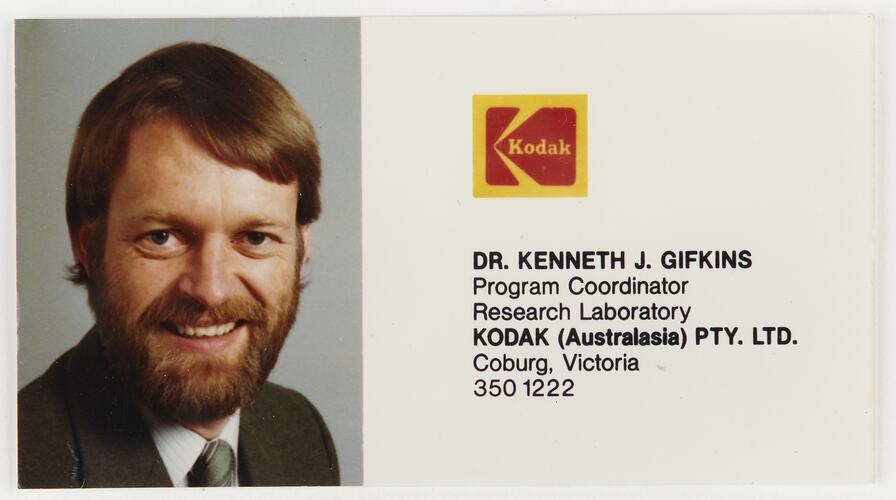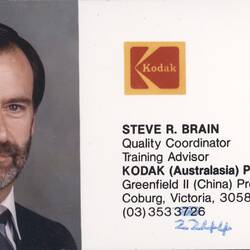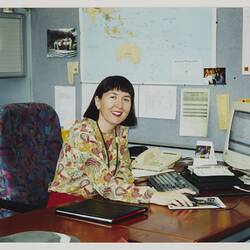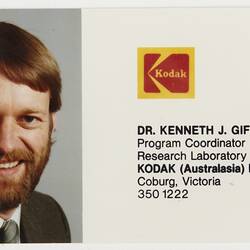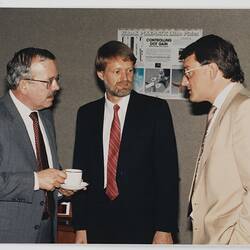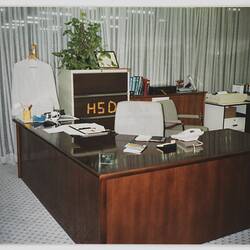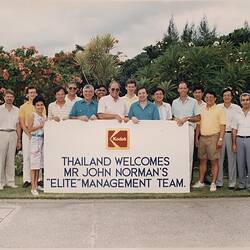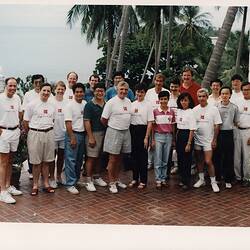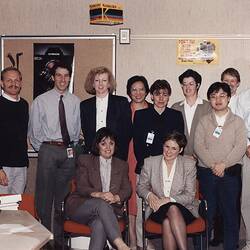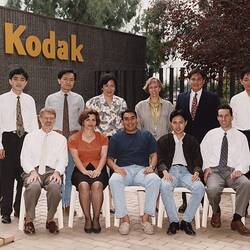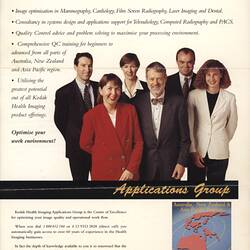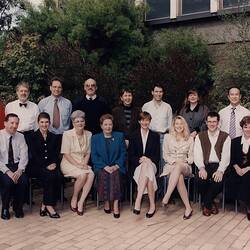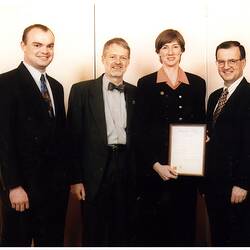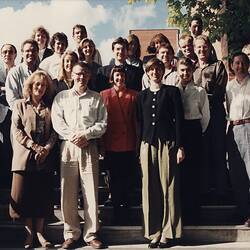Summary
From research scientist to sales manager, 1971-2007.
Dr Ken Gifkins, Kodak Australasia Pty Ltd: From Research Scientist to Sales Manager Kodak Health, 1971 - 2007
After completing a Ph.D. in solid state physics, Ken Gifkins accepted a job as a research scientist at Kodak's Coburg plant. His career path led him into health science and eventually sales management.
Research laboratories
In 1971 Ken commenced working in the research laboratory at Kodak's Coburg plant, where he remained for 14 years. The laboratory's role was to support and improve the manufacture of film and other photographic products at Kodak's Coburg plant. Ken's research involved experimenting with light sensitive emulsions and the process of coating emulsions onto a base material to make film.
One innovative project in the early 1980s explored a method of improving adhesion of the emulsions to the base, by running the base through a plasma - electronically charged ionised gas under low pressure - before it was coated with emulsion. As program coordinator, Ken led a multi-disciplinary team of electronics engineers, chemists, and engineering draftsmen in what he described as 'the biggest R & D project that the Coburg lab had ever run'. The process was patented and Eastman Kodak, the parent company in USA, considered using it for special film products made at its Rochester plant.
Manufacturing Manager, Materials
In 1985 Ken moved to the Manufacturing Division as quality leader for black and white film. The main black and white product manufactured at Coburg was x-ray film for the health industry. Some film was made for graphic arts, although it was soon to be phased out. The office imaging product, microfilm - used for storing records - was made overseas and brought to Coburg in large rolls for cutting and spooling.
At the time Kodak was changing its approach to quality control, moving responsibility from a separate quality control department to the manufacturing staff. Ken explains that the combined Australian market and Asian export market for x-ray film could be satisfied with just one and a half days of production every six weeks. This meant that with a rotating shift crew, workers would go months without the experience of doing the particular process of x-ray film coating, which was different to the regular job of coating colour film and paper:
'So our challenge was to help them to better get through that process each time. Get started with perfect product, and keep it running right through the one and a half days of continuous coating. And we managed to do it. It was an interesting group exercise.'
In 1986 Ken set up the Technical Centre, to provide technical resources for the Health, Graphics and Office Imaging business units. The centre provided customers with training in new products and assisted customers with technical problems. The centre only lasted a few years, but the concept moved with Ken to the Health Sciences Group.
Kodak Health
In 1989 Kodak Australasia ceased manufacturing x-ray film, and Ken was offered the position of Manager of Technical Development for the Health Sciences Group, later known as Kodak Health. He found it an easy career choice:
'I didn't want to stay in manufacturing and do something else, because I'd started to meet customers and work with them. And I thought, I like this business. They're interesting people. It's a good ethical business to be part of. . It was right at this transition time when things were starting to go to digital imaging in a big way and Kodak was actually taking notice and producing products that related to that.'
Kodak had recently launched a new laser printer for printing CT, MRI and ultrasound images onto film. Kodak Health sold these imported machines, installed them with the appropriate software interface so that they worked with the customer's existing equipment, and provided training and after-sales technical support.
Kodak Health was also the sole agent in Australia and Asia for a Dutch brand of x-ray machine called AMBER (Advanced Multiple Beam Equalisation Radiography). One of Ken's first tasks was to visit the Netherlands for training in AMBER, then he worked with the Royal Melbourne Hospital to organise the sale and installation Australia's first AMBER unit. The mid 1990s was a period of rapid evolution in medical imaging technology. Ken observes:
'When AMBER came out it was just so far ahead of anything in the market place. And almost instantly it was being replaced by digital technologies.'
The technical support group needed more people with digital expertise, so Darren Ash and Elizabeth Delahunty were recruited from within Kodak. While the group 'became much more involved in digital in the leading edge of our technology', Ken's role remained focused on conventional x-ray imaging, for which Kodak still supplied film, imported from Mexico. He ran quality control workshops for breast screening units, and assisted clients with their film processing problems. In most cases, the problems were caused by incorrect use of the processing equipment and chemicals. Ken became acquainted with many radiologists and radiographers around Australia.
Dental imaging
Ken began to specialise in dental x-ray products which, because of the small market, Kodak sold through dealers. In about the year 2000 Ken became Manager of Dental Business for Australia and New Zealand. He provided technical support and trained sales teams for the dealers in the correct use of the film, so that they could pass on the knowledge to their customers.
Carestream
In 2007 Kodak sold its global Health Group to Onex, a Canadian firm, which set up a new company called Carestream Health. Carestream took over all of Kodak Health's assets and offered to keep all of its staff and their entitlements. Ken welcomed the decision, believing that it would strengthen the business. Ken's job as channel manager and regulatory manager involved looking after the distribution side and making sure that the products met the requirements of the Therapeutic Goods Administration. After completing the regulatory registration of products to Carestream, Ken retired.
References
Beale, Nigel, 'The History of Kodak in Australia', 1983 (unpublished manuscript).
HT 39532 & HT 39533 - Oral History Interview with Dr Ken Gifkins, interviewed by Lesley Alves 8 January 2015 and 29 January 2015.
More Information
-
Keywords
-
Authors
-
Article types
